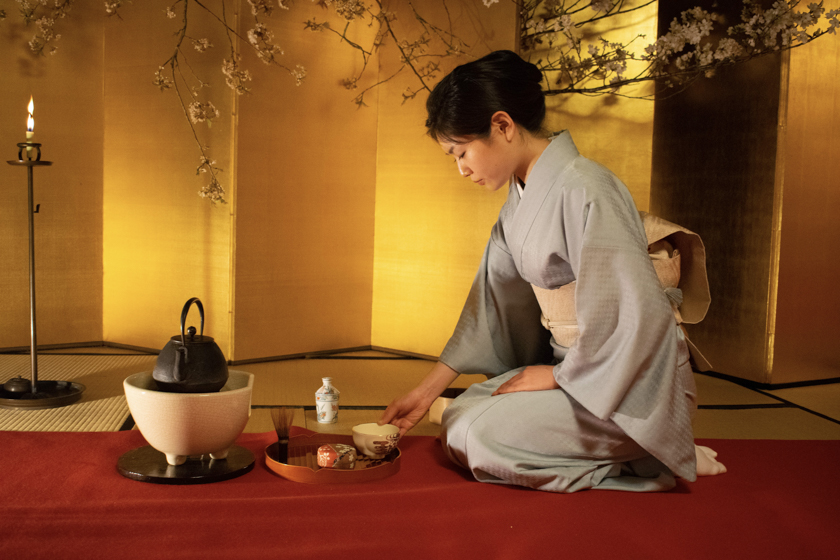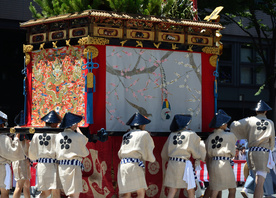Table of contents:
History of the Japanese Tea Ceremony
Types of Tea Ceremonies
What to Expect from a Tea Ceremony
Tea Ceremony Etiquette
Where to Find Tea Experiences in Japan
As much as Japan can seem a modern, even futuristic destination at times, it’s still a country with enduring traditions that easily fascinate international visitors. One such custom is the Japanese tea ceremony, a ritualistic activity that is an artform all to itself. Known as the Way of Tea and called sadō, chanoyu or chadō in Japanese, the custom is a ceremonial serving of matcha green tea within a traditional tearoom.
Many travellers want to experience the hospitality of this tea experience in Japan, something which is becoming easier and easier these days. To give you an idea of what this experience is like, we’ve put together this quick Japanese tea ceremony guide.
History of the Japanese Tea Ceremony
Before getting into the rituals and details of a Japanese tea ceremony, it’s important to first understand where that tradition stems from. The history of the tea ceremony, but Japan’s relationship with green tea is even longer. Tea was first introduced to Japan from China in the 9th century and was initially exclusive to monks and later the Imperial family. It was between the 12th and 16th centuries that drinking tea grew in popularity, eventually reaching every corner of Japanese society.
It wasn’t until the 15th and 16th century that sado became an established part of Japanese tea culture. Two figures had a profound effect on its development, Murata Jukō and Sen no Rikyū. Juko was a Buddhist who established the philosophical principles of sado, namely harmony, respect, purity and tranquillity. Rikyū, on the other hand, promoted the idea that each meeting was unique, making it special and worth treasuring through a special ceremony. From these ideals, many schools of sado, have involved and are practised to this day.
Types of Tea Ceremonies
Although tea ceremonies are often talked about in broad terms, there are actually many different types that take place. One way ceremonies can differ is their level of formality, which may come as a surprise given how traditional and formal the custom appears to outsiders. Believe it or not, the kind of tea ceremony most tourists see is actually the informal type, known as chakai. The more formal alternative, known as chaji, features a full meal, multiple teas and can last as much as 4 hours.
The other way tea ceremonies can vary is due to the time of day or season in which they take place. This means there are subtle differences between tea ceremonies held in summer versus winter, but also morning ceremonies compared to evening ceremonies. For instance, a tea ceremony that takes place in the early-evening in summer is known as yuuzari-no-chaji and involves watching the sunset.
What to Expect from a Tea Ceremony
Although they may be excited to witness a tea ceremony in Japan up close, many travellers don’t know exactly what’s in store for them. Essentially, the ceremony is a performance where a host serves their guests green tea in a formal manner. The ceremony typically takes place in a traditional room, lined with tatami mats, following a rigid process of steps.
Tourists usually experience chakai ceremonies, which last from 30 minutes to an hour. Traditional ceremonies usually host about 4 or 5 guests, who are each served a teacup of thin green tea. More formal sado include the drinking of thick green tea, which is drank from a bowl shared by guests. Besides the tea, chakai gathering usually also includes sweets and possibly a light meal.
Tea Ceremony Etiquette
Being a traditional activity that has lasted centuries, you can bet there’s plenty of customs and etiquette associated with a Japanese tea experience. To ensure you behave appropriately and not cause offence, it’s best to try and learn these norms before you go. However, if you are going to an English-speaking ceremony for tourists, chances are the etiquette will be explained to you as part of it. To help you get started though, here are some pointers:
- Along with the role of host there is the shokyaku, the main guest who is responsible for interacting with the teishu or host.
- Bow once after the tea is served, again just before drinking the tea and again after putting the empty cup down.
- Try to drink the tea in only two or three sips, ensuring that any patterns on the cup are facing away from you.
- Be sure to wear white socks on the day as you will need to remove your shoes upon entering and try to avoid tight or revealing clothing for this traditional experience.
Where to Find Tea Experiences in Japan

For tourists, there are two kinds of tea ceremony experience that you can have. If you just want to watch a tea ceremony take place, there are venues that allow you to watch and not participate. However, there are also tea ceremony venues that let you take part, kimono and all.
Since tea ceremonies are naturally conducted in Japanese, which many international travellers do not speak, there has been a recent rise in English language tea ceremonies. Choosing an English language ceremony allows tourists to better understand the performance as it’s happening and properly participate.
The most common tea experiences for tourists are centred in popular destinations like Tokyo and Kyoto, with options like:
- The MAIKOYA Kimono Tea Ceremony has venues in Tokyo, Kyoto and Osaka, and is easily one of the most recommended options for tourists, especially those who want to wear a kimono for the experience.
- Asakusa Jidaiya is located in the popular tourist area of Asakusa in Tokyo, providing the option to watch or participate in the sado.
- An interesting alternative to these tea venues is to try AirKitchen, a platform that makes it possible to enjoy a more intimate tea ceremony hosted by a local in their own house. A great way to share the experience on a more one-on-one basis.
- For a less touristy option, consider visiting the Uji region and its many, many teahouses.





